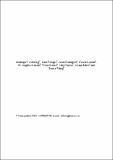Por favor, use este identificador para citar o enlazar a este item:
http://hdl.handle.net/10261/51544COMPARTIR / EXPORTAR:
 SHARE SHARE
 CORE
BASE CORE
BASE
|
|
| Visualizar otros formatos: MARC | Dublin Core | RDF | ORE | MODS | METS | DIDL | DATACITE | |

| Campo DC | Valor | Lengua/Idioma |
|---|---|---|
| dc.contributor.author | Aubourg, Santiago P. | - |
| dc.contributor.author | Vinagre, Julia | - |
| dc.contributor.author | Rodríguez, Alicia | - |
| dc.contributor.author | Losada, Vanesa | - |
| dc.contributor.author | Larraín, Mª Angélica | - |
| dc.contributor.author | Quitral, Vilma | - |
| dc.contributor.author | Gómez, Julio | - |
| dc.contributor.author | Maier, Liliana | - |
| dc.contributor.author | Wittig, Emma | - |
| dc.date.accessioned | 2012-06-14T09:54:46Z | - |
| dc.date.available | 2012-06-14T09:54:46Z | - |
| dc.date.issued | 2005 | - |
| dc.identifier.citation | European Journal of Lipid Science and Technology 107(6): 411-417 (2005) | es_ES |
| dc.identifier.issn | 1438-7697 | - |
| dc.identifier.uri | http://hdl.handle.net/10261/51544 | - |
| dc.description | 7 páginas, 4 figuras, 2 tablas | es_ES |
| dc.description.abstract | Coho salmon (Oncorhynchus kisutch) is a fatty fish species whose farming production has greatly increased in recent years. Lipid damage produced during Coho salmon chilled storage was studied for up to 24 d. Lipid hydrolysis (free fatty acids, FFA) and oxidation (conjugated dienes; peroxide value, PV; thiobarbituric acid index, TBA-i; fluorescent compounds formation, FR; browning development) were determined and compared to lipid composition (polyene index, PI; astaxanthin, AX) changes and sensory assessment (rancid odour development) results. Most lipid damage indices developed slowly during storage; thus, values obtained for FFA, PV, TBA-i and FR were in all cases under 1.5 g/100 g, 4.0 meq oxygen/kg lipid, 0.40 mg malondialdehyde/kg muscle and 0.40, respectively. Odour assessment showed a significant (p <0.05) rancidity development at day 10, when compared to starting fish material; then, non-acceptable values were obtained at days 19 and 24. The PI analysis showed not many differences during the storage time, with the lowest mean value at day 19. AX analysis indicated a relatively high content in the white muscle, which was maintained till the end of the experiment. A low oxidation development is concluded for Coho salmon lipids when compared to other fatty fish species under the same chilling conditions. AX was found to contribute to the oxidation stability of Coho salmon lipids, due to its free radical scavenger properties | es_ES |
| dc.language.iso | eng | es_ES |
| dc.publisher | Wiley-VCH | es_ES |
| dc.rights | openAccess | es_ES |
| dc.subject | Coho salmon | es_ES |
| dc.subject | Aquaculture | es_ES |
| dc.subject | Chilling | es_ES |
| dc.subject | Racidity | es_ES |
| dc.subject | Odour | es_ES |
| dc.subject | Astaxanthin | es_ES |
| dc.subject | Quality | es_ES |
| dc.title | Rancidity development during the chilled storage of farmed Coho salmon (Oncorhynchus kisutch) | es_ES |
| dc.type | artículo | es_ES |
| dc.identifier.doi | 10.1002/ejlt.200401069 | - |
| dc.description.peerreviewed | Peer reviewed | es_ES |
| dc.relation.publisherversion | http://dx.doi.org/10.1002/ejlt.200401069 | es_ES |
| dc.identifier.e-issn | 1438-9312 | - |
| dc.type.coar | http://purl.org/coar/resource_type/c_6501 | es_ES |
| item.grantfulltext | open | - |
| item.openairecristype | http://purl.org/coar/resource_type/c_18cf | - |
| item.fulltext | With Fulltext | - |
| item.cerifentitytype | Publications | - |
| item.languageiso639-1 | en | - |
| item.openairetype | artículo | - |
| Aparece en las colecciones: | (IIM) Artículos | |
Ficheros en este ítem:
| Fichero | Descripción | Tamaño | Formato | |
|---|---|---|---|---|
| Rancidity_development_during_chilled_storage.pdf | 279,69 kB | Adobe PDF |  Visualizar/Abrir |
CORE Recommender
SCOPUSTM
Citations
31
checked on 28-may-2024
WEB OF SCIENCETM
Citations
28
checked on 22-feb-2024
Page view(s)
328
checked on 28-may-2024
Download(s)
1.155
checked on 28-may-2024
Google ScholarTM
Check
Altmetric
Altmetric
NOTA: Los ítems de Digital.CSIC están protegidos por copyright, con todos los derechos reservados, a menos que se indique lo contrario.
